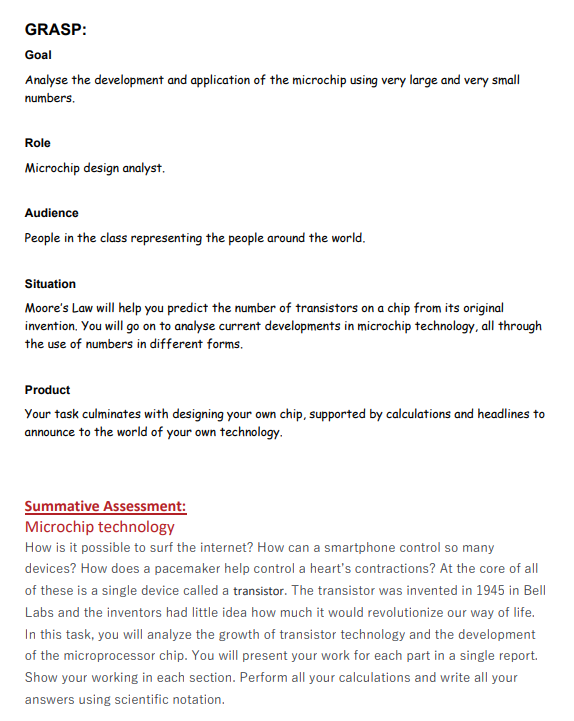
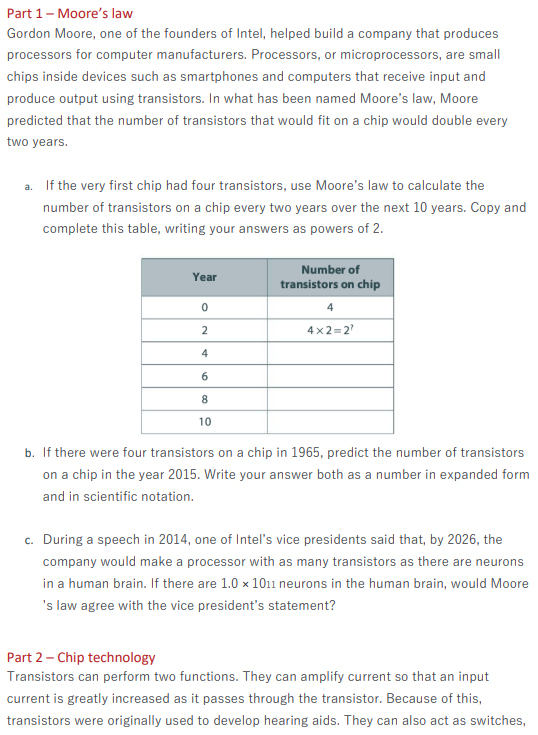

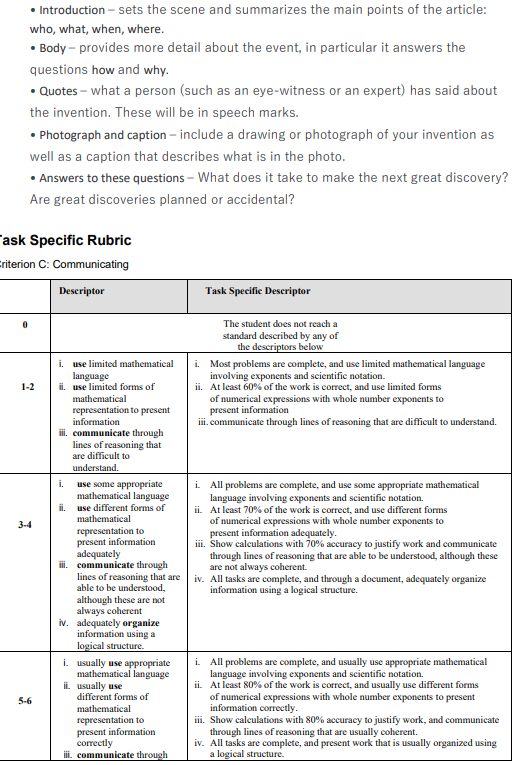
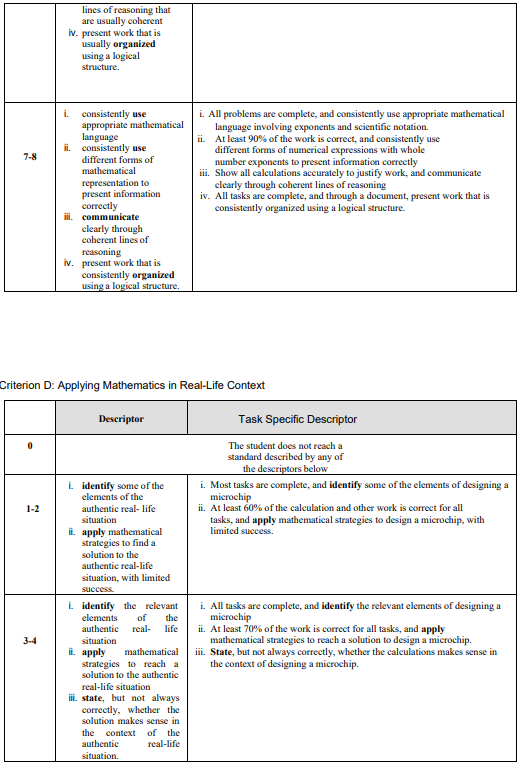
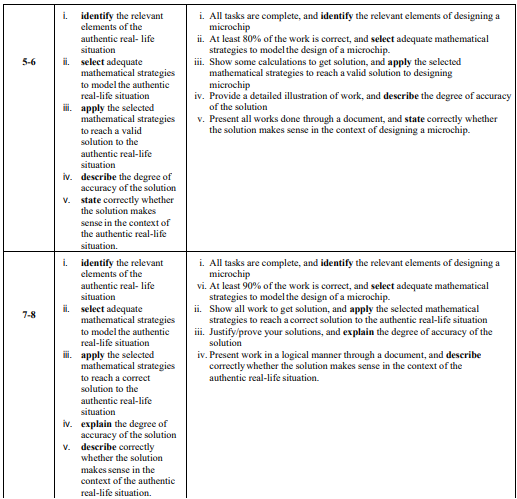
GRASP: Goal Analyse the development and application of the microchip using very large and very small numbers. Role Microchip design analyst. Audience People in the class representing the people around the world. Situation Moore's Law will help you predict the number of transistors on a chip from its original invention. You will go on to analyse current developments in microchip technology, all through the use of numbers in different forms. Product Your task culminates with designing your own chip, supported by calculations and headlines to announce to the world of your own technology Summative Assessment: Microchip technology How is it possible to surf the internet? How can a smartphone control so many devices? How does a pacemaker help control a heart's contractions? At the core of all of these is a single device called a transistor. The transistor was invented in 1945 in Bell Labs and the inventors had little idea how much it would revolutionize our way of life. In this task, you will analyze the growth of transistor technology and the development of the microprocessor chip. You will present your work for each part in a single report. Show your working in each section. Perform all your calculations and write all your answers using scientific notation. Part 1 - Moore's law Gordon Moore, one of the founders of Intel, helped build a company that produces processors for computer manufacturers. Processors, or microprocessors, are small chips inside devices such as smartphones and computers that receive input and produce output using transistors. In what has been named Moore's law, Moore predicted that the number of transistors that would fit on a chip would double every two years. a. If the very first chip had four transistors, use Moore's law to calculate the number of transistors on a chip every two years over the next 10 years. Copy and complete this table, writing your answers as powers of 2. Year 0 Number of transistors on chip 4 4x2 = 2 2 4 6 8 10 b. If there were four transistors on a chip in 1965, predict the number of transistors on a chip in the year 2015. Write your answer both as a number in expanded form and in scientific notation. c. During a speech in 2014, one of Intel's vice presidents said that, by 2026, the company would make a processor with as many transistors as there are neurons in a human brain. If there are 1.0 x 1011 neurons in the human brain, would Moore 's law agree with the vice president's statement? Part 2 - Chip technology Transistors can perform two functions. They can amplify current so that an input current is greatly increased as it passes through the transistor. Because of this, transistors were originally used to develop hearing aids. They can also act as switches, being either "on" or "off". This allows the transistor to store two different numbers, either a 0 (off) or a 1 (on). Originally, vacuum tubes were used as switches, but these were large and required a lot of power. a. Smartphones have chips in them that can contain 3.3 billion transistors. If each transistor weighs 5.1 x 10-23 grams, find the total mass of the transistors in a smartphone. b. If each chip has a length of 35 nanometers (nm), how many would you need to circle the Earth, which has a radius of 6371km? C. Supercomputers have been developed that are much larger and can perform many more calculations than ordinary desktop or laptop computers. One such supercomputer, the Titan, has 4.485 x 10-* transistors in its central processing unit (CPU) and another 1.3268 x 10- transistors in its graphics processing unit (GPU). Find the total number of transistors in the Titan. Show your working and give your answers in standard form. d. Intel estimates that about 12 quintillion transistors are shipped around the globe each year. If that represents 10000 times the number of ants on the planet, find the number of ants on Earth. Performance Task: Part 3 - Design your own What if you could design your own processor? How small would you make it? How many transistors could you fit on it? The size of transistors has decreased dramatically since they were first invented. Assume you will use transistors that are approximately rectangular and measure 35nm by 14nm. a. Select a chip size that sounds impressive (e.g. a fingernail). Find its area. (You may choose to research the area or calculate it after taking measurements.) b. Find the number of transistors that you will be able to fit on your chosen area. c. If transistors costs $0.000000003 USD each, find the cost of the transistors on your chip. d. Create a headline to announce your technology to the world. e. Write a newspaper article about your invention and create a snazzy name for your chip. Your article must include the following: Headline - usually only a few words. It's purpose is to attract the interest of the reader by giving a hint as to what the article is about in a concise way. By-line - the author of the article. Introduction - sets the scene and summarizes the main points of the article: who, what, when, where. Body - provides more detail about the event, in particular it answers the questions how and why. Quotes - what a person (such as an eye-witness or an expert) has said about the invention. These will be in speech marks. Photograph and caption - include a drawing or photograph of your invention as well as a caption that describes what is in the photo. Answers to these questions - What does it take to make the next great discovery? Are great discoveries planned or accidental? Cask Specific Rubric riterion C: Communicating Descriptor Task Specific Descriptor 0 The student does not reach a standard described by any of the descriptors below i. Most problems are complete, and use limited mathematical language involving exponents and scientific notation. ii. At least 60% of the work is correct, and use limited forms of numerical expressions with whole number exponents to present information iii.communicate through lines of reasoning that are difficult to understand. 1-2 i. use limited mathematical language ii. use limited forms of mathematical representation to present information iii. communicate through lines of reasoning that are difficult to understand. i. use some appropriate mathematical language ii. use different forms of mathematical representation to present information adequately ii. communicate through lines of reasoning that are able to be understood, although these are not always coherent iv. adequately organize information using a logical structure .. usually use appropriate mathematical language ii. usually use different forms of mathematical representation to present information correctly iii. communicate through i. All problems are complete, and use some appropriate mathematical language involving exponents and scientific notation. ii. At least 70% of the work is correct, and use different forms of numerical expressions with whole number exponents to present information adequately. iii. Show calculations with 70% accuracy to justify work and communicate through lines of reasoning that are able to be understood, although these are not always coherent. iv. All tasks are complete, and through a document, adequately organize information using a logical structure. 5-6 i. All problems are complete, and usually use appropriate mathematical language involving exponents and scientific notation. ii. At least 80% of the work is correct, and usually use different forms of numerical expressions with whole number exponents to present information correctly. iii. Show calculations with 80% accuracy to justify work, and communicate through lines of reasoning that are usually coherent. iv. All tasks are complete, and present work that is usually organized using a logical structure lines of reasoning that are usually coherent iv. present work that is usually organized using a logical structure. 7-8 i. consistently use appropriate mathematical language ii. consistently use different forms of mathematical representation to present information correctly ii. communicate clearly through coherent lines of reasoning iv. present work that is consistently organized using a logical structure. i. All problems are complete, and consistently use appropriate mathematical language involving exponents and scientific notation. ii. At least 90% of the work is correct, and consistently use different forms of numerical expressions with whole number exponents to present information correctly iii. Show all calculations accurately to justify work, and communicate clearly through coherent lines of reasoning iv. All tasks are complete, and through a document, present work that is consistently organized using a logical structure. Criterion D: Applying Mathematics in Real-Life Context Descriptor Task Specific Descriptor 0 The student does not reach a standard described by any of the descriptors below i. Most tasks are complete, and identify some of the elements of designing a microchip ii. At least 60% of the calculation and other work is correct for all tasks, and apply mathematical strategies to design a microchip, with limited success. 1-2 i identify some of the elements of the authentic real-life situation ii. apply mathematical strategies to find a solution to the authentic real-life situation, with limited success i identify the relevant elements of the authentic real- life situation mathematical strategies to reach a solution to the authentic real-life situation iii. state, but not always correctly, whether the solution makes sense in the context of the authentic real-life situation 3-4 i. All tasks are complete, and identify the relevant elements of designing a microchip ii. At least 70% of the work is correct for all tasks, and apply mathematical strategies to reach a solution to design a microchip. iii. State, but not always correctly, whether the calculations makes sense in the context of designing a microchip. ii. apply 5-6 i. All tasks are complete, and identify the relevant elements of designing a microchip ii. At least 80% of the work is correct, and select adequate mathematical strategies to model the design of a microchip- iii. Show some calculations to get solution, and apply the selected mathematical strategies to reach a valid solution to designing microchip iv. Provide a detailed illustration of work, and describe the degree of accuracy of the solution v. Present all works done through a document, and state correctly whether the solution makes sense in the context of designing a microchip i. identify the relevant elements of the authentic real-life situation ii. select adequate mathematical strategies to model the authentic real-life situation ii. apply the selected mathematical strategies to reach a valid solution to the authentic real-life situation iv. describe the degree of accuracy of the solution V. state correctly whether the solution makes sense in the context of the authentic real-life situation. i. identify the relevant elements of the authentic real-life situation ii. select adequate mathematical strategies to model the authentic real-life situation iii. apply the selected mathematical strategies to reach a correct solution to the authentic real-life situation iv. explain the degree of accuracy of the solution V. describe correctly whether the solution makes sense in the context of the authentic real-life situation. 7-8 i. All tasks are complete, and identify the relevant elements of designing a microchip vi. At least 90% of the work is correct, and select adequate mathematical strategies to model the design of a microchip ii. Show all work to get solution, and apply the selected mathematical strategies to reach a correct solution to the authentic real-life situation iii. Justify/prove your solutions, and explain the degree of accuracy of the solution iv. Present work in a logical manner through a document, and describe correctly whether the solution makes sense in the context of the authentic real-life situation. GRASP: Goal Analyse the development and application of the microchip using very large and very small numbers. Role Microchip design analyst. Audience People in the class representing the people around the world. Situation Moore's Law will help you predict the number of transistors on a chip from its original invention. You will go on to analyse current developments in microchip technology, all through the use of numbers in different forms. Product Your task culminates with designing your own chip, supported by calculations and headlines to announce to the world of your own technology Summative Assessment: Microchip technology How is it possible to surf the internet? How can a smartphone control so many devices? How does a pacemaker help control a heart's contractions? At the core of all of these is a single device called a transistor. The transistor was invented in 1945 in Bell Labs and the inventors had little idea how much it would revolutionize our way of life. In this task, you will analyze the growth of transistor technology and the development of the microprocessor chip. You will present your work for each part in a single report. Show your working in each section. Perform all your calculations and write all your answers using scientific notation. Part 1 - Moore's law Gordon Moore, one of the founders of Intel, helped build a company that produces processors for computer manufacturers. Processors, or microprocessors, are small chips inside devices such as smartphones and computers that receive input and produce output using transistors. In what has been named Moore's law, Moore predicted that the number of transistors that would fit on a chip would double every two years. a. If the very first chip had four transistors, use Moore's law to calculate the number of transistors on a chip every two years over the next 10 years. Copy and complete this table, writing your answers as powers of 2. Year 0 Number of transistors on chip 4 4x2 = 2 2 4 6 8 10 b. If there were four transistors on a chip in 1965, predict the number of transistors on a chip in the year 2015. Write your answer both as a number in expanded form and in scientific notation. c. During a speech in 2014, one of Intel's vice presidents said that, by 2026, the company would make a processor with as many transistors as there are neurons in a human brain. If there are 1.0 x 1011 neurons in the human brain, would Moore 's law agree with the vice president's statement? Part 2 - Chip technology Transistors can perform two functions. They can amplify current so that an input current is greatly increased as it passes through the transistor. Because of this, transistors were originally used to develop hearing aids. They can also act as switches, being either "on" or "off". This allows the transistor to store two different numbers, either a 0 (off) or a 1 (on). Originally, vacuum tubes were used as switches, but these were large and required a lot of power. a. Smartphones have chips in them that can contain 3.3 billion transistors. If each transistor weighs 5.1 x 10-23 grams, find the total mass of the transistors in a smartphone. b. If each chip has a length of 35 nanometers (nm), how many would you need to circle the Earth, which has a radius of 6371km? C. Supercomputers have been developed that are much larger and can perform many more calculations than ordinary desktop or laptop computers. One such supercomputer, the Titan, has 4.485 x 10-* transistors in its central processing unit (CPU) and another 1.3268 x 10- transistors in its graphics processing unit (GPU). Find the total number of transistors in the Titan. Show your working and give your answers in standard form. d. Intel estimates that about 12 quintillion transistors are shipped around the globe each year. If that represents 10000 times the number of ants on the planet, find the number of ants on Earth. Performance Task: Part 3 - Design your own What if you could design your own processor? How small would you make it? How many transistors could you fit on it? The size of transistors has decreased dramatically since they were first invented. Assume you will use transistors that are approximately rectangular and measure 35nm by 14nm. a. Select a chip size that sounds impressive (e.g. a fingernail). Find its area. (You may choose to research the area or calculate it after taking measurements.) b. Find the number of transistors that you will be able to fit on your chosen area. c. If transistors costs $0.000000003 USD each, find the cost of the transistors on your chip. d. Create a headline to announce your technology to the world. e. Write a newspaper article about your invention and create a snazzy name for your chip. Your article must include the following: Headline - usually only a few words. It's purpose is to attract the interest of the reader by giving a hint as to what the article is about in a concise way. By-line - the author of the article. Introduction - sets the scene and summarizes the main points of the article: who, what, when, where. Body - provides more detail about the event, in particular it answers the questions how and why. Quotes - what a person (such as an eye-witness or an expert) has said about the invention. These will be in speech marks. Photograph and caption - include a drawing or photograph of your invention as well as a caption that describes what is in the photo. Answers to these questions - What does it take to make the next great discovery? Are great discoveries planned or accidental? Cask Specific Rubric riterion C: Communicating Descriptor Task Specific Descriptor 0 The student does not reach a standard described by any of the descriptors below i. Most problems are complete, and use limited mathematical language involving exponents and scientific notation. ii. At least 60% of the work is correct, and use limited forms of numerical expressions with whole number exponents to present information iii.communicate through lines of reasoning that are difficult to understand. 1-2 i. use limited mathematical language ii. use limited forms of mathematical representation to present information iii. communicate through lines of reasoning that are difficult to understand. i. use some appropriate mathematical language ii. use different forms of mathematical representation to present information adequately ii. communicate through lines of reasoning that are able to be understood, although these are not always coherent iv. adequately organize information using a logical structure .. usually use appropriate mathematical language ii. usually use different forms of mathematical representation to present information correctly iii. communicate through i. All problems are complete, and use some appropriate mathematical language involving exponents and scientific notation. ii. At least 70% of the work is correct, and use different forms of numerical expressions with whole number exponents to present information adequately. iii. Show calculations with 70% accuracy to justify work and communicate through lines of reasoning that are able to be understood, although these are not always coherent. iv. All tasks are complete, and through a document, adequately organize information using a logical structure. 5-6 i. All problems are complete, and usually use appropriate mathematical language involving exponents and scientific notation. ii. At least 80% of the work is correct, and usually use different forms of numerical expressions with whole number exponents to present information correctly. iii. Show calculations with 80% accuracy to justify work, and communicate through lines of reasoning that are usually coherent. iv. All tasks are complete, and present work that is usually organized using a logical structure lines of reasoning that are usually coherent iv. present work that is usually organized using a logical structure. 7-8 i. consistently use appropriate mathematical language ii. consistently use different forms of mathematical representation to present information correctly ii. communicate clearly through coherent lines of reasoning iv. present work that is consistently organized using a logical structure. i. All problems are complete, and consistently use appropriate mathematical language involving exponents and scientific notation. ii. At least 90% of the work is correct, and consistently use different forms of numerical expressions with whole number exponents to present information correctly iii. Show all calculations accurately to justify work, and communicate clearly through coherent lines of reasoning iv. All tasks are complete, and through a document, present work that is consistently organized using a logical structure. Criterion D: Applying Mathematics in Real-Life Context Descriptor Task Specific Descriptor 0 The student does not reach a standard described by any of the descriptors below i. Most tasks are complete, and identify some of the elements of designing a microchip ii. At least 60% of the calculation and other work is correct for all tasks, and apply mathematical strategies to design a microchip, with limited success. 1-2 i identify some of the elements of the authentic real-life situation ii. apply mathematical strategies to find a solution to the authentic real-life situation, with limited success i identify the relevant elements of the authentic real- life situation mathematical strategies to reach a solution to the authentic real-life situation iii. state, but not always correctly, whether the solution makes sense in the context of the authentic real-life situation 3-4 i. All tasks are complete, and identify the relevant elements of designing a microchip ii. At least 70% of the work is correct for all tasks, and apply mathematical strategies to reach a solution to design a microchip. iii. State, but not always correctly, whether the calculations makes sense in the context of designing a microchip. ii. apply 5-6 i. All tasks are complete, and identify the relevant elements of designing a microchip ii. At least 80% of the work is correct, and select adequate mathematical strategies to model the design of a microchip- iii. Show some calculations to get solution, and apply the selected mathematical strategies to reach a valid solution to designing microchip iv. Provide a detailed illustration of work, and describe the degree of accuracy of the solution v. Present all works done through a document, and state correctly whether the solution makes sense in the context of designing a microchip i. identify the relevant elements of the authentic real-life situation ii. select adequate mathematical strategies to model the authentic real-life situation ii. apply the selected mathematical strategies to reach a valid solution to the authentic real-life situation iv. describe the degree of accuracy of the solution V. state correctly whether the solution makes sense in the context of the authentic real-life situation. i. identify the relevant elements of the authentic real-life situation ii. select adequate mathematical strategies to model the authentic real-life situation iii. apply the selected mathematical strategies to reach a correct solution to the authentic real-life situation iv. explain the degree of accuracy of the solution V. describe correctly whether the solution makes sense in the context of the authentic real-life situation. 7-8 i. All tasks are complete, and identify the relevant elements of designing a microchip vi. At least 90% of the work is correct, and select adequate mathematical strategies to model the design of a microchip ii. Show all work to get solution, and apply the selected mathematical strategies to reach a correct solution to the authentic real-life situation iii. Justify/prove your solutions, and explain the degree of accuracy of the solution iv. Present work in a logical manner through a document, and describe correctly whether the solution makes sense in the context of the authentic real-life situation












